Small-scale farming practices contribute meaningfully to global food production. This ancient tradition of living off the land has evolved into a modern lifestyle that emphasizes sustainability and self-reliance.
Today, individuals worldwide are embracing this way of life as a commitment to environmental consciousness and adaptability. From traditional farming communities in Asia to urban gardens in Europe, people are tailoring sustainable practices to their unique circumstances.
By merging time-tested wisdom with technological innovation, this lifestyle has become increasingly accessible. In cities, rooftops are transformed into gardens, while community spaces encourage collaboration and shared resources. Suburban dwellers combine solar energy with backyard gardens and small-scale livestock keeping. Rural communities expand these practices by integrating renewable energy systems and sustainable resource management.
The flexibility of self-sufficient living is its greatest strength. Whether you live in an urban apartment, a suburban home, or a rural property, you don’t need vast amounts of land or perfect conditions to start. Apartment residents can grow herbs in window boxes, while families with larger spaces might plant vegetable gardens or raise chickens. The key lies in understanding your environment and making the most of your available resources.
Introduction to Homesteading
Since 2020, the rise of sustainable living has gained unprecedented momentum, reflecting a broader global awareness about food security, resource management, and independence. Tools like smart irrigation systems, solar-powered devices, and seed-saving initiatives empower individuals to adopt sustainable practices, regardless of location.
Online platforms such as Permaculture Global and Homesteaders of the World connect like-minded individuals, providing valuable resources and guidance for both beginners and experienced practitioners. These communities highlight that embracing self-reliance is achievable and rewarding, no matter the setting.
By blending the wisdom of the past with modern innovation, self-sufficiency has evolved into a global movement. From small-scale urban gardens to fully independent rural setups, this lifestyle proves that sustainable living is not just achievable—it’s adaptable to any environment.
Modern Homesteading: What It Is and How to Start?
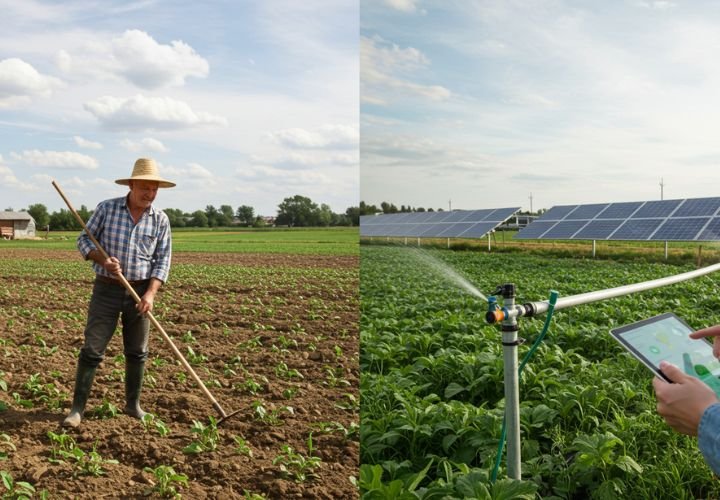
Modern homesteading blends traditional self-sufficiency with innovation and technology. This global movement has evolved from ancient farming practices into a contemporary approach to sustainable living. It encompasses small-scale farming, renewable energy usage, and food preservation techniques. These principles are flexible and can be applied whether you have acres of land or just a small apartment.
The Evolution of Homesteading: Throughout history, people worldwide have practiced self-sufficient living to meet their daily needs. Modern homesteading builds on this foundation by focusing on environmental consciousness and independence. Today, an impressive 60% of homesteaders utilize renewable energy sources such as wind or solar power. They balance their lifestyle with gardening, animal husbandry, and sustainable practices. Additionally, cooking from scratch and preserving food remain central elements, showcasing how traditional wisdom is adapted to modern challenges.
As technology advances, homesteaders are now incorporating smart irrigation systems, energy-efficient tools, and community networks to enhance their practices. These innovations ensure that self-sufficient living is not only practical but also aligned with contemporary environmental priorities.
Homesteading for Beginners: For newcomers, starting small is key. Begin with
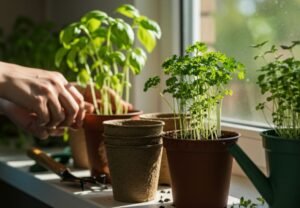
manageable projects like container gardening or raising small animals such as quail for eggs. These activities allow you to build confidence while gradually expanding your self-sufficient practices. Mastering basic skills, such as cooking from scratch or learning how to preserve seasonal produce, creates a solid foundation for sustainable living.
Planting herbs, for instance, is an excellent entry point for beginners. Herbs are easy to grow in small spaces, require minimal maintenance, and provide fresh ingredients for cooking—all while connecting you to the essence of self-sufficient living.
Adapting Homesteading to Urban Life: The beauty of modern homesteading lies in its adaptability. Even urban dwellers are embracing sustainable practices, with approximately 10% of city residents now participating in small-scale homesteading. Techniques like container gardening, rooftop gardens, and participation in community growing spaces prove that sustainable living is achievable in any location.
This growing movement demonstrates that self-reliance and environmental stewardship are no longer confined to rural areas. Whether you live in a bustling metropolis or a quiet suburban neighborhood, modern homesteading offers a path toward a more sustainable and fulfilling lifestyle.
Principles and Values of Modern Homesteading
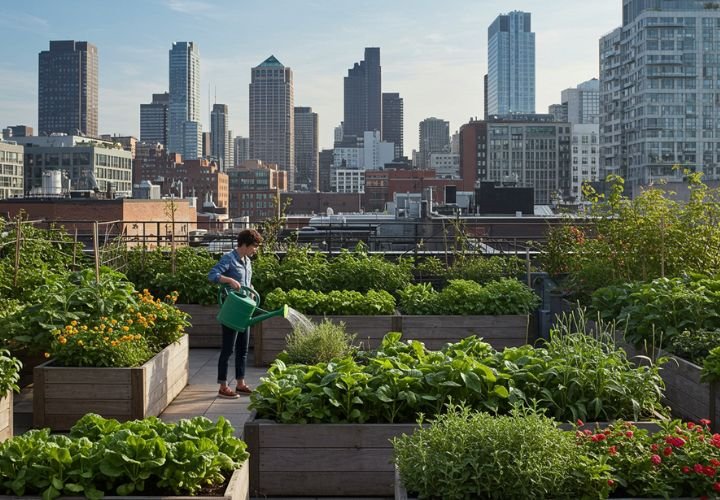
Modern homesteading is guided by three fundamental principles: sustainability, self-reliance, and a deep connection with nature. These values shape every decision, offering a path to a more independent and environmentally conscious lifestyle.
Sustainability in homesteading means creating systems that endure. Homesteaders prioritize eco-friendly solutions, such as composting, recycling, and harnessing renewable energy like solar or wind power. They embrace DIY practices, mastering skills like building, repairing, and crafting. These projects not only reduce consumption but also strengthen their ability to live independently and adapt to challenges.
Self-reliance is another cornerstone of this lifestyle. It involves producing and preserving food, managing resources creatively, and reducing dependency on external systems.
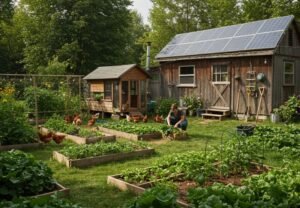
Homesteaders often cultivate gardens, raise small livestock, or preserve seasonal produce through techniques like canning or fermenting. Additionally, they practice resourceful living, finding innovative ways to reuse materials and minimize waste.
A connection with nature lies at the heart of homesteading. Whether in urban apartments or rural farms, homesteaders strive to live harmoniously with the environment.
This principle goes beyond sustainability; it’s about respecting natural cycles, protecting ecosystems, and finding fulfillment in simpler, nature-aligned living. Each decision, from planting a garden to building a shelter, reflects a commitment to coexistence with the planet.
By embracing these principles, modern homesteading offers both personal fulfillment and environmental benefits. It empowers individuals to take control of their lifestyles while contributing positively to the world around them.
Modern Homesteading in Different Settings
Homesteading is a lifestyle that adapts to any environment, whether urban, suburban, or rural. Each setting presents unique opportunities and challenges, but all share the same core principles of sustainability, self-reliance, and environmental stewardship. Here’s how homesteading thrives in different places:
Urban Homesteading
Urban homesteading transforms city living into a sustainable adventure. With limited space, city dwellers rely on innovative solutions like balcony gardens, indoor composting, and vertical gardening. These techniques maximize small areas, allowing urbanites to grow fresh produce and reduce waste.
Community gardens play a crucial role in urban homesteading, offering shared spaces for
growing food and fostering collaboration. These green hubs have proven that even in concrete landscapes, collective efforts can create a significant environmental impact.
Urban homesteaders are also embracing technologies like compact composting systems and hydroponics to enhance productivity in tight spaces.
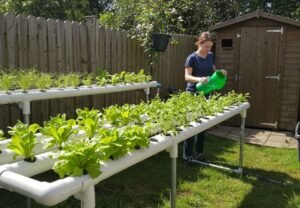
Key Tip: Start with micro-projects like growing herbs on windowsills or creating a small compost bin. Over time, these small steps can evolve into a fulfilling urban homesteading lifestyle.
Suburban Homesteading
Suburban environments strike a balance between space availability and accessibility, making them an excellent setting for modern homesteading. With more room than cities, suburban homesteaders can maintain backyard chickens, beehives, and larger garden plots. These activities support food preservation techniques like canning, freezing, and fermenting, thanks to the additional storage space suburban homes often provide.
Suburban areas also offer beginners the perfect environment to develop DIY skills. Projects like building raised garden beds, installing rainwater collection systems, or starting a small greenhouse are common in these settings. The combination of space, resources, and accessibility makes suburban homesteading a natural stepping stone for those transitioning into a more self-sufficient lifestyle.
Key Tip: Leverage your backyard space for diverse activities. For instance, grow vegetables alongside pollinator-friendly plants to support local ecosystems while boosting garden productivity.
Rural Homesteading
Rural homesteading unlocks the full potential of self-sufficient living, thanks to the availability of larger land areas and natural resources. This setting provides ideal conditions for extensive crop cultivation, animal husbandry, and off-grid systems. With additional space, rural homesteaders can implement a variety of sustainable practices that go beyond basic food production to include long-term resource management systems.
One of the greatest strengths of rural homesteading is its capacity to create complete self-sufficient ecosystems. These may include:
- Agroforestry systems that combine tree cultivation with crop and livestock production to enhance biodiversity and soil health.

Rural homesteading offers endless possibilities, from gardening and livestock to innovative aquaponics systems. - Renewable energy setups, such as wind turbines or large-scale solar arrays, to power homes and farming operations.
- Integrated composting systems that recycle organic waste to maintain soil fertility.
Rural settings also provide opportunities for specialized production, such as beekeeping, aquaponics, or mushroom farming, which can support both personal needs and local markets. This versatility allows rural homesteaders to experiment with diverse approaches to sustainability.
However, the principles of homesteading remain consistent across all environments. Success doesn’t rely on the amount of land you have but on how effectively you use it to achieve your sustainability goals. Whether working with acres of farmland or a small garden, the key is to plan thoughtfully, use resources wisely, and embrace practices that align with your needs and values.
Challenges and Rewards of Homesteading
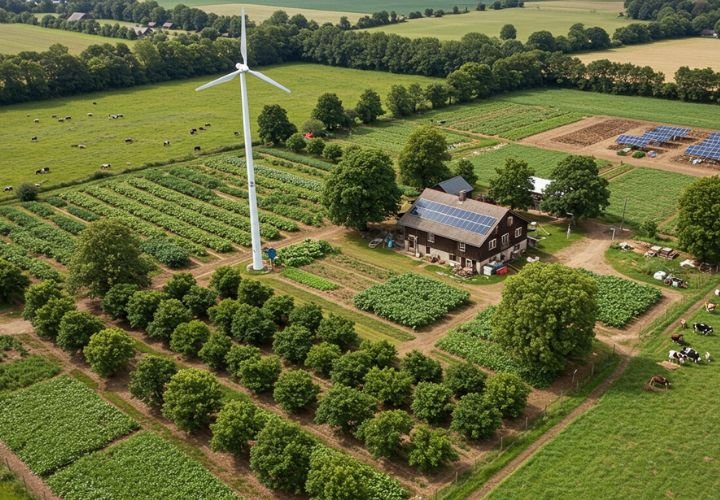
Understanding the Challenges:
Homesteading is a fulfilling lifestyle, but it comes with its share of challenges. One of the most significant hurdles is the time commitment. Maintaining food production, caring for animals, and managing sustainable systems require year-round effort. The learning curve can also be steep, as homesteaders often need to develop a wide range of skills, from gardening and food preservation to basic construction and animal care. Patience and dedication are key to navigating this process.
Another challenge is the financial investment. Setting up a homestead, whether it’s an urban balcony garden or a larger rural property, involves upfront costs. Expenses for tools, seeds, compost, and potential infrastructure like irrigation or renewable energy systems must be carefully planned. Additionally, finding the right location demands research to ensure it aligns with your sustainability goals and lifestyle needs.
Embracing the Rewards:
Despite these challenges, the rewards of homesteading are profound. One of the most notable benefits is reduced living costs. Growing your own food and adopting sustainable practices like composting and rainwater harvesting can significantly lower monthly expenses.
Homesteading also fosters a deeper connection with nature. Engaging in hands-on activities, like planting, harvesting, or preserving food, provides a sense of purpose and fulfillment. This connection often improves mental well-being, as the lifestyle encourages mindfulness and a slower pace of life.
Community Building:
Another invaluable reward is the opportunity to build community connections. Sharing
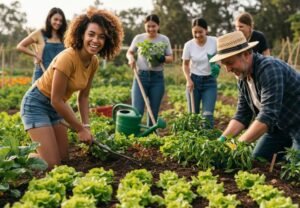
knowledge, exchanging resources, or participating in local markets creates meaningful relationships. Homesteading brings people together, whether through collaborative gardening projects in urban settings or knowledge-sharing events in rural areas.
Personal Growth and Accomplishment:
The sense of accomplishment that comes with homesteading is unmatched. From harvesting your first crops to successfully preserving food for winter or constructing a functional garden system, each milestone builds confidence and skills. These achievements highlight the independence and resilience gained through this lifestyle.
While homesteading requires effort and careful planning, the combination of personal growth, environmental sustainability, and cost savings makes it a rewarding journey for many. It’s not just about the practical benefits—it’s about embracing a lifestyle that aligns with your values and fosters a deeper connection with the world around you.
Common Myths About Homesteading
Misconceptions about homesteading often discourage people from exploring this rewarding lifestyle. Let’s debunk some of the most common myths and uncover the realities of modern homesteading.
Myth: Homesteading Requires a Lot of Land
One of the biggest misconceptions is that you need vast amounts of land to homestead. This couldn’t be further from the truth. Homesteading can thrive in cities, suburbs, or even small apartments with the right approach.
For example, urban gardens have seen a 60% increase in popularity over the last five years, proving that self-sufficient living is possible even in limited spaces. Community gardens, which have grown by over 20%, also highlight how people are working together in urban areas to embrace sustainability and grow their own food. Techniques like vertical gardening, container planting, and balcony composting make small-space homesteading achievable for anyone.
Myth: Homesteaders Are Completely Self-Sufficient
A common misconception about homesteading is that it means complete independence, free from modern conveniences. In reality, most homesteaders strike a balance between self-reliance and using external resources. While they grow a significant portion of their food—often cutting grocery bills by up to 50%—they still purchase essentials like grains, spices, or equipment.
Homesteading today is about fostering independence while remaining connected to a community. Many urban homesteaders dedicate 10-20 hours weekly to activities like gardening or caring for small animals, which helps them develop practical skills. In fact, 70% of homesteaders report significant improvements in self-sufficiency and resourcefulness.
Why Homesteading Matters Today

In a fast-paced, consumer-driven world, homesteading offers a refreshing alternative. It challenges overconsumption and promotes sustainable living, allowing individuals to take control of their food sources and reduce their environmental impact.
This growing movement is attracting more people every day. Whether through online searches or community workshops, thousands are discovering how to start homesteading—even without land. The rise of apartment homesteading and innovative methods like container gardening and vertical farming make it possible for city dwellers to embrace this lifestyle.
Accessible for Everyone
Homesteading isn’t limited to those with large properties. There are 13 creative ways to start without owning land, such as joining community gardens, renting small plots, or using shared urban farming spaces. These methods show that even those in small apartments can make a meaningful shift toward sustainability.
Homesteading as a Source of Income
Small homesteads can also be profitable. With 17 proven ways to generate income—from selling fresh produce and homemade goods to offering workshops—homesteading becomes more than a lifestyle; it’s an opportunity to build financial security. This sense of responsibility and achievement often brings pride to homesteaders, reinforcing their connection to the land and community.
Skills for a Sustainable Life
For beginners, homesteading provides an incredible opportunity to learn. There are 27 essential skills for starting, from composting and canning to raising small animals. Seasonal activities, like preparing for winter with sustainable practices, ensure homesteaders can thrive year-round. With resources like 150 simple canning recipes and composting guides, even newcomers can make meaningful progress.
Conclusion
This guide has explored the many facets of modern homesteading, from its historical roots to its evolution in today’s world. Homesteading is no longer limited to rural living; it has expanded to include cities and suburbs, making self-sufficiency accessible to a broader audience.
Living a self-sufficient lifestyle brings countless benefits. Through activities like DIY projects, canning, and composting, homesteaders not only reduce their environmental impact but also enrich their lives. With over 27 beginner-friendly skills to learn and 70 creative uses for wood ash, the possibilities for growth and discovery are endless.
Homesteading is also a practical way to save money. From sourcing affordable supplies to reducing property taxes, this lifestyle can significantly cut costs. Whether you’re working with a small urban balcony or a sprawling 30-acre property, there are meaningful steps you can take toward self-reliance. Even during the colder months, there’s always an opportunity to learn new skills, keeping your homesteading journey active year-round.
At its core, homesteading is about connection—to the land, to your community, and to a more sustainable way of life. Whether you’re nurturing a small garden in the city or managing a larger rural homestead, the principles of homesteading can guide you toward a greener, more intentional existence.
Yes, challenges like regulations and repairs may arise, but the rewards far outweigh the obstacles. Homesteading is more than just a lifestyle—it’s a fulfilling journey of independence, sustainability, and personal growth.
FAQ
What is homesteading and how does it work?
Homesteading is about living a self-sufficient life. You grow your own food and raise animals. You also make your own goods. This lifestyle focuses on being sustainable. You can live this way in cities, suburbs, or the countryside.
What does homesteading mean today?
Now, homesteading is about living in a way that you can support yourself. It includes gardening and raising animals like chickens. You also preserve food and make things for the house. This can happen in both cities and suburbs, not just rural areas.
Is homesteading only for rural areas?
No, you can homestead anywhere. In cities, people garden in small spaces and compost. They even raise small animals. In the suburbs, they might have bigger gardens. They may also keep chickens and bees.
What are the basic principles of homesteading?
Homesteading is based on being self-reliant and sustainable. It’s also about keeping things simple. You grow your own food and try to waste less. Using renewable resources and making the best of what you have are key.
How can beginners start homesteading?
If you’re new, start with small projects. Try gardening in pots or raising quail. Use any space you have to produce something useful. Then, you can try more complex projects as you learn.
What is urban homesteading?
Urban homesteading is about living self-sufficiently in a city. People grow plants in containers or use vertical gardens. They compost and may raise chickens or quail.
What challenges might I face with homesteading?
There are challenges like managing your time and dealing with start-up costs. Space might be tight, and there’s a lot to learn. But many people find it rewarding and worth the effort.
Are homesteaders completely self-sufficient?
Homesteaders aim for self-sufficiency but rarely do everything on their own. They might still buy some things. Yet, they produce much of their own food and resources. It’s about balance.
What’s the importance of homesteading today?
Homesteading today helps with living sustainably and reducing environmental harm. It connects us to nature. It also makes communities stronger and more self-reliant. Plus, it’s a fulfilling way to live.


